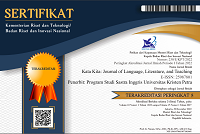CONVERTED VILLAIN: A STUDY ON GRU’S CHANGING CHARACTER TRAITS IN DESPICABLE ME
DOI:
https://doi.org/10.9744/katakita.3.1.16-21Keywords:
Analisis Internal dan Eksternal Perusahaan Formulasi Strategi, Porter Five Forces, Strategi Keunggulan BiayaAbstract
This article concerns with Gru’s character development in Despicable Me. In this movie, Gru, the father of three daughters is described as a villain. However, later on Gru becomes a good man. In this article, I am interested in analyzing the reasons or factors why Gru’s character traits change and how his changing character traits effect him and others. In my analysis I examine the process of Gru’s changing character traits by using the theories of characterization and conflict. Beside those theories I also use the theory of personality to get a better understanding of the effect of his character development. The findings show that his three daughters’ love plays a role in changing his character. As a result, Gru becomes a good man and he is well accepted by others. Through Gru’s experiences, I conclude that it is very important that people should show their understanding to others and be mindful to others feeling. In this way, they can have a more meaningful life.References
Bloom, Edward. A and Lilian D. Bloom. (1969). The Variety of Fiction : A critical Anthology. New York: The Odyssey Press.
CBC News. (2013). J. K. Rowling to pen Harry Potter spinoff film series. Retrieved from http://www.cbc.ca/news/arts/j-k-rowling-to-pen-harry-potter-spinoff-film-series-1.1701754.Accessed on January 23, 2015.
Dweek, S. C. (2008). Can Personality Be Change? The role of Beliefs in Personality and Change.Current Directions in Psychological Science, 17, 391 – 394.
Holman, C.H., & Harmon, W. (1986).A Handbook to Literature. New York: Macmillan Publishing Company.
Holman, Hugh C. (1996). A Handbook to literature. Indianapolis: Odyssey.
Perrine, Laurence. (1983). Literature: structure, sound, and sense (4thed). San Diego: Harcourt Brace Jovanovich.
Popenoe, David. (1971). Sociology. New York: Appleton-Century-Crofts.
Roberts, W., &Mroczek, D. (2008). Personality Trait Change in Adulthood. Current Directions in Psychological Science, 17, 31 – 35. Retrieved from http://www.jstor.org/stable/20183244
Shaw, H. (1972). Dictionary of literary terms. New York: McGrawhil Book Company.
Wilks, L. (2009). The Stability of personality over time as a function of personality trait dominance.Griffith University undergraduate student psychology Journal, 1, 1 – 9.
Revelle, W. (2007). Personality Processes. Annual Reviews Psychology, 46, 295 – 328. Retrieved from http://www.annualreviews.org/aronlin
Downloads
Issue
Section
License
Authors who publish with this journal agree to the following terms:- Authors retain copyright and grant the journal right of first publication with the work simultaneously licensed under a Creative Commons Attribution License that allows others to share the work with an acknowledgement of the work's authorship and initial publication in this journal.
- Authors are able to enter into separate, additional contractual arrangements for the non-exclusive distribution of the journal's published version of the work (e.g., post it to an institutional repository or publish it in a book), with an acknowledgement of its initial publication in this journal.
- Authors are permitted and encouraged to post their work online (e.g., in institutional repositories or on their website) prior to and during the submission process, as it can lead to productive exchanges, as well as earlier and greater citation of published work (See The Effect of Open Access).














